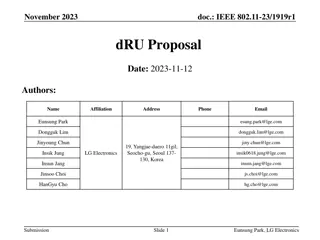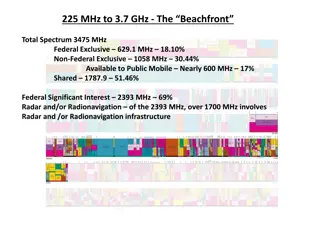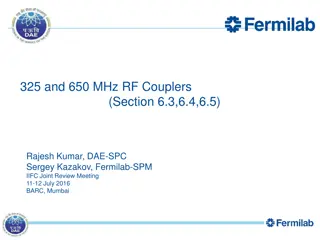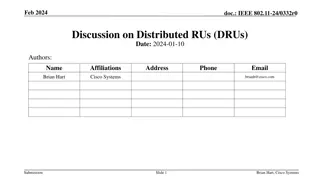Efficient dRU Tone Plan Design for UHR Communications
The document discusses the signaling techniques for Ultra-High Rate (UHR) communications using dRU (dense RU) for overcoming PSD limitations. It elaborates on the methods to construct a dRU tone plan and indicate dRUs within rRUs. The design involves defining different sizes of dRUs, combining tones
0 views • 28 slides
Overview of ESRF-EBS 352 MHz RF System Upgrade at 26th ESL RF Meeting
The 26th ESL RF Meeting held at Elettra in Trieste discussed the status and upgrades of the ESRF-EBS 352 MHz RF system. The meeting covered topics such as the EBS RF layout, HOM damped cavities, RF ECO-Mode, ongoing RF projects, and the replacement of klystrons with SSAs for a 4th harmonic RF system
0 views • 16 slides
Cryostat Engineering for SC Devices Training at CERN - November 2022
Explore the technical training on Cryostat Engineering for Superconducting devices at CERN in November 2022. Dive into the design aspects, static heat loads, and mass flows for a 400 MHz cryomodule. Tasks include conceptual design of cryostats, calculating thermal parameters, supporting systems, and
0 views • 10 slides
Challenges and Requirements for Bandwidth Indication in IEEE 802.11
The document discusses challenges and requirements related to bandwidth indication in RTS/CTS frames with PPDU in 320 MHz, focusing on scenarios where bandwidth signaling may lead to misinterpretation by stations. It highlights the need for dynamic bandwidth and preamble puncturing information in RT
3 views • 21 slides
IEEE 802.11-20/0668r1: EHT BSS Configuration Proposal
The document discusses the configuration of a 320 MHz BSS in the context of 6 GHz regulations, focusing on EHT operation elements such as channel width indication, CCFS principles, and BSS advertisement settings. It proposes design principles for managing legacy and EHT STA operations, emphasizing s
0 views • 14 slides
Bitmap Indication for OFDMA Transmission
Dec. 2020 introduces a preamble puncture bitmap indication for 20/40 MHz OFDMA transmission, proposing to use '1111' when no puncturing is applied. The straw poll suggests adding this indication to the TGbe SFD. The submission highlights the specific bit values for punctured 20 MHz channels within a
2 views • 5 slides
IEEE 802.11-20/0479r0 240 MHz Channelization Options
The document discusses agreements on 240 MHz channelization in IEEE 802.11-20/0479r0, presenting three options: contiguous non-overlapping channels, any combination of three consecutive 80 MHz channels, and puncturing of a 320 MHz channel. Various considerations and questions are raised regarding th
0 views • 12 slides
Proposal for EHT 320 MHz PPDU Support in EDCA Ranging for IEEE 802.11-23/0391r1
The document outlines a proposal to enable EHT 320 MHz PPDU support for EDCA ranging in IEEE 802.11-23/0391r1. It discusses the implementation of FTM legacy ranging, the importance of wider bandwidths, and the necessary changes in the standard to incorporate this support. The proposal aims to enhanc
0 views • 6 slides
IEEE 802.11-20/0095 PHY-Related Agreements for SST
IEEE 802.11-20/0095 outlines agreements related to PHY aspects impacting the definition of Spatial Stream Tapping (SST) in 802.11 standards. The focus is on enabling 80 MHz operating stations to participate in 160 MHz OFDMA, including in non-primary 80 MHz scenarios. Various considerations and scena
1 views • 11 slides
Proposed 80 MHz EHT LPI PPDU Format for IEEE 802.11-20/1347r1
The document presents the proposed LPI PPDU format for IEEE 802.11-20/1347r1, focusing on enhancing the robustness of the preamble and payload in non-OFDMA frames. The format includes repetitions of U-SIG and E-SIG symbols, optimizing DCM gain for improved performance. Simulation results show advant
0 views • 12 slides
Is HID 125kHz better than 13.56 MHz?
Explore the differences between HID 125kHz and 13.56MHz. Understand which frequency offers better security and performance for your needs.
6 views • 6 slides
PSD-based Energy Detect Threshold (EDT) in ETSI 5 GHz Standard
ETSI BRAN adopted a PSD-based EDT into the 5 GHz standard, specifying thresholds for energy detection levels. The new definition replaces the previous -72 dBm/20 MHz EDT, offering a compromise between power limits and channel configurations. Detailed examples and operational guidelines are provided
0 views • 6 slides
IEEE 802.11-23/1919r1dRU Proposal for Range Extension and RvR Enhancement
This proposal introduces dRU support for 11bn to overcome PSD limitations, enabling range extension and RvR enhancement. It reviews previous dRU contributions in UHR SG and details new proposals including distributed tones across channels, dRU tone plans in different MHz channels, and pilot designs
0 views • 22 slides
IEEE 802.11-21/0012r1 Considerations on Open Issues in PHY Requirements
In the January 2021 document IEEE 802.11-21/0012r1, discussions were held on open issues related to PHY requirements, including LO requirements for 320 MHz transmission, EVM requirements for 1024 QAM and BPSK-DCM-DUP, minimum sensitivity for 4K QAM and BPSK-DCM-DUP, and channel rejection levels. Sug
0 views • 12 slides
Way Forward on Release Independence for 35 and 45 MHz in Mobile Networks
Discussion at the 3GPP TSG-RAN-WG4 Meeting #97-e focused on release options for 35 and 45 MHz frequencies. Different options were explored for release independence, hardware capabilities, backward compatibility issues, and commercial implementation aspects concerning various stakeholders such as T-M
0 views • 10 slides
MC-OOK Symbol Design for IEEE 802.11 - March 2018
Introducing MC-OOK waveforms with low peak-to-average power ratio for IEEE 802.11, utilizing 256-QAM modulation and 4 MHz bandwidth. The design methodology involves generating time-domain waveforms, transforming to frequency domain, and proposing symbols with and without DC subcarriers. Detailed sym
0 views • 20 slides
Military Spectrum Utilization in the 225-399.9 MHz Band
The 225-399.9 MHz band is crucial for military operations, utilized by NATO, allied nations, and the Coast Guard for tactical and strategic communications. It supports mobile-satellite systems, MUOS, air-to-ground communication, and more. The band also facilitates aeronautical communication, trunked
2 views • 21 slides
Progress and Scope of 325 and 650 MHz RF Couplers
The document outlines the technical progress and scope of work regarding the development of 325 MHz and 650 MHz RF couplers for the Joint Review Meeting. It includes details on milestones, design and fabrication timelines, prototype testing results, production updates, and plans for increasing power
0 views • 16 slides
RF Leakage Investigations & Atomic Clock Signal Phase Drift Analysis
RF signals ranging from 100 kHz to 150 MHz are utilized for achieving resonance in optical cavities. DC Ground Isolation Units help decouple DC grounds and shield leakage. Spectrum analysis using RF analyzers reveals peaks possibly from neighboring balun leakages. Solutions involve increasing capaci
0 views • 14 slides
Development of 650 MHz RF Power Systems for PIP-II Linac
The project involves designing and fabricating 325 MHz and 650 MHz RF power systems for PIP-II Linac. Various milestones, including the development of 40 kW RF systems, testing prototypes, and collaboration between RRCAT and Fermilab, are outlined. The high-level goal is to achieve specific power le
0 views • 16 slides
Understanding NXDN Technology in West Central Florida
NXDN is an ultra narrowband digital mode with 6.25 KHz FDMA modulation, offering clear audio and data streaming with support for multiple talkgroups. It provides superior weak signal performance, decoding down to -116 dBm, ideal for indoor use. First-generation NXDN radios lack certain features comp
0 views • 15 slides
AN/PRC-117F Characteristics Overview
AN/PRC-117F (or R/T-1796) is a versatile radio system with a frequency range from 30 MHz to 512 MHz, covering VHF-LOW, VHF-HIGH, UHF, SATCOM, SINCGARS, and HAVE QUICK modes. It offers multiple modulation methods, programmable presets, ECCM features, power outputs, and encryption capabilities. With a
0 views • 25 slides
IEEE 802.11-23/1067r1 TB Ranging with EHT and HE TB PPDU Overview
This document discusses the use of 320 MHz bandwidth in TB ranging for IEEE 802.11-23/1067r1, focusing on EHT and HE TB frames. It examines the decision trees regarding the use of EHT TB ranging NDP, limitations on frame mixing, and bandwidth reduction for Location Measurement Report (LMR). Key cons
0 views • 8 slides
Tuning and Matching of 1 and 2 Loops Antenna
The aim of the project is to match the impedance of the circuit to 50 ohms at the resonance frequency of 14.8 MHz. The process involves calculating the impedance, working at low frequencies to determine key parameters, calculating capacitors, determining Q, and finally calculating tuning and matchin
0 views • 25 slides
IEEE 802.11-24/0078r1 dRU Design Approach for 20 MHz
Introduction to the design approach for Distributed Resource Units (dRUs) in the IEEE 802.11-24/0078r1 document for achieving the TGbn PAR goal of Rate-vs-Range. The focus is on designing resource units with low power spectral density to enhance transmit power per tone efficiently. Various tone plan
0 views • 16 slides
Proposal for Improved Channel Access Efficiency in IEEE 802.11 Networks
The proposal addresses the inefficiencies in utilizing secondary channels in IEEE 802.11 networks, aiming to enhance access to wideband channels (>20 MHz) when the primary channel is busy. It introduces a mechanism for APs and STAs to access available secondary channels while the primary channel is
0 views • 7 slides
Thermal and Mechanical Simulation of Beryllium Window for MICE 201 MHz Cavity
Conducted thermal and mechanical simulations using TEM3P for the beryllium window of the MICE 201 MHz cavity. Analysis focused on temperature distribution, frequency shifts, thermal deformation control, and stress considerations under varying operation conditions and material properties. Detailed in
0 views • 11 slides
Overview of PERLE Injector Design & ALICE Electron Gun Re-optimisation
The PERLE injector, part of the Powerful Energy Recovery Linac for Experiments (PERLE), operates at 7 MeV injection energy with a bunch charge of 500 pC and a bunch repetition rate of 40.1 MHz. The layout includes a DC photoemission electron gun, bunching and focusing sections, and a superconducting
0 views • 50 slides
2.4 GHz CubeSat Communications System Overview
The 2.4 GHz CubeSat Communications System, led by Robert Bui, aims to establish a reliable data link between the SDS-1 Cube Satellite and the ASU ground station. Operating on the 13 cm amateur ham radio band at frequencies of 2400-2450 MHz, the system utilizes a Transceiver (MHX-2420) with a link ra
0 views • 10 slides
Understanding Microwave and Radar Engineering
Microwave and radar engineering involve the study of electromagnetic radiation with wavelengths ranging from one meter to one millimeter and frequencies between 300 MHz and 300 GHz. This form of technology plays a crucial role in communication systems due to its advantages such as large bandwidth, b
0 views • 105 slides
Challenges and Proposed Solutions in Next-Generation Vehicle Technologies
The document discusses the background of IEEE 802.11 NGV technologies, focusing on the need for a new 10 MHz PHY for DSRC systems. It highlights issues related to channelization and introduces new PHY capabilities in 802.11n, 802.11ac, and draft 802.11ax standards, offering insights into evolving fe
0 views • 14 slides
Discussion on Distributed RUs (DRUs) in IEEE 802.11-24/0332r0
The document discusses Distributed RUs (DRUs) as a solution to work around 6 GHz regulations limiting transmit PSD per MHz. DRU energizes a few subcarriers per MHz to improve link budget by 11 dB at the cost of data rate scaling. It also examines the problem of throughput degradation in DRU with ins
0 views • 9 slides































